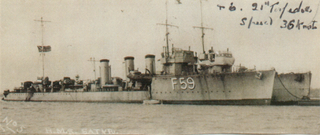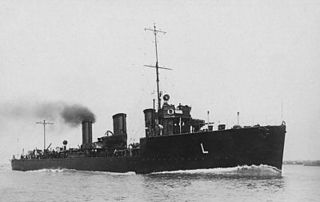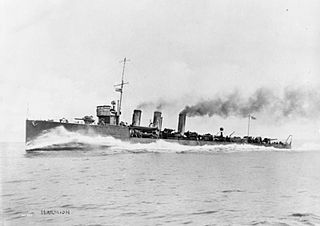
HMS Sorceress was an R-class destroyer which served with the Royal Navy during World War I. Launched on 29 August 1916, the vessel operated as part of the Grand Fleet until it was disbanded in 1919. In 1917, the ship took part in action against the German Sixth Destroyer Flotilla and was one of those credited with bounty for the German auxiliary cruiser Konprinz Willhelm. The destroyer was sold to be broken up on 29 April 1927.

HMS Sharpshooter was an R-class destroyer which served with the Royal Navy during World War I. Launched on 27 February 1917, the ship joined the Harwich Force, undertaking convoy escort duties. The vessel also took part in the Navy’s bombardment of Ostend later that year. On 1 June 1918, the destroyer rescued Captain A. C. Sharwood, one of the first pilots of the Royal Australian Navy, who ditched his Sopwith 2F.1 Camel nearby. After the war, Sharpshooter joined the Navy gunnery training establishment at Plymouth, but did not stay long and was reduced to Reduced Complement on 5 March 1919. The Royal Navy was rationalising its destroyer force and Sharpshooter, deemed superfluous, was sold to be broken up on 29 April 1927.

HMS Springbok was an R-class destroyer which served with the Royal Navy during World War I. The R class were an improvement on the preceding M-class, including using geared steam turbines. Launched on 9 March 1917, the vessel operated as part of the Harwich Force on escort duties. In 1917, the destroyer, along with sister ship Thruster, captured the German merchant ships Brietzig and Pellworm. After the conflict, the destroyer initially was posted to the navy's torpedo school but was soon afterwards reduced to reserve. After less than ten years in service, Springbok was sold on 16 December 1926 and broken up.

HMS Laurel was a Laforey-class destroyer which served with the Royal Navy. Launched on 6 May 1913 as HMS Redgauntlet, the ship was renamed on 30 September under an Admiralty order to become one of the first alphabetical class destroyers. On commissioning, the vessel joined the 3rd Destroyer Flotilla and operated as part of the Harwich Force during the First World War. During Battle of Heligoland Bight, Laurel led a flotilla that pursued German torpedo boats, engaging with G194 and G196, and was damaged in action with the cruiser Mainz. The vessel also played a minor role in the Battles of Dogger Bank, Dover Strait and Jutland. With the cessation of hostilities, the ship was placed in reserve and scrapped on 1 November 1921.

HMS Liberty was a Laforey-class destroyer that served with the Royal Navy during the First World War. Launched on 15 September 1913 as HMS Rosalind, the ship was renamed on 30 September under an Admiralty order to become one of the first alphabetical class destroyers. On commissioning, the vessel joined the Third Destroyer Flotilla and operated as part of the Harwich Force. During Battle of Heligoland Bight, Liberty engaged with the German torpedo boats G194 and G196, and scored two hits on the cruiser Mainz. On 8 February 1917, the destroyer rammed and sank the German submarine UC-46. The vessel also played a minor role in the battles of Dogger Bank, Dover Strait and Jutland, as well as acting as a convoy escort and patrolling the Dover Barrage. With the cessation of hostilities, the ship was placed in reserve and sold to be broken up on 5 November 1921.

HMS Linnet was a Laforey-class destroyer that served with the Royal Navy during the First World War. Launched on 16 August 1913 as HMS Havock, the ship was renamed on 30 September under an Admiralty order to become one of the first destroyers in a class named alphabetically. This convention subsequently became the norm. On commissioning, the vessel joined the Third Destroyer Flotilla and operated as part of the Harwich Force. The destroyer was first commanded by Commander Loftus Jones who named his daughter Linnette after the ship. During the War, the destroyer took part in the Battle of Heligoland Bight in 1914, and escorted minelayers on missions to lay mines. It was during one the latter missions that the ship was nearly hit by a gun hurled from the stricken minelayer Amphion. With the cessation of hostilities, the ship was placed in reserve and sold to be broken up on 4 November 1921.

HMS Medina was a Admiralty M-class destroyer which served with the Royal Navy during the First World War. The M class were an improvement on the previous L class, capable of higher speed. Originally laid down as HMS Redmill by J. Samuel White at East Cowes on the Isle of Wight, the vessel was renamed before being launched in 1916. The ship was allocated to the Grand Fleet and spent much of its service in anti-submarine warfare, either escorting convoys or involved in submarine hunting patrols. Although the destroyer attacked a number of German submarines, none were sunk. After the War, Medina was reassigned to a defence flotilla in Portsmouth and was eventually sold to be broken up in 1921.

HMS Llewellyn was a Laforey-class destroyer that served with the Royal Navy. Laid down on 14 December 1912 as HMS Picton, the ship was renamed on 30 September 1913 under an Admiralty order to become one of the first alphabetical class destroyers, being launched on 30 October. On commissioning, the vessel joined the Third Destroyer Flotilla and operated as part of the Harwich Force during the First World War. The destroyer took part in the Battle of Heligoland Bight, as well as undertaking anti-submarine patrols and escort duties. It was during one of these patrols on 4 December 1916 that the vessel unsuccessfully attacked the German submarine UB-18. On 17 March 1917, the destroyer was struck in the bow by a torpedo launched by a German torpedo boat while rescuing survivors from the sunk destroyer Paragon, but returned to port safely by steaming backwards. With the cessation of hostilities, the ship was placed in reserve. Although subsequently offered for sale to the Finnish Navy, Llewellyn was instead withdrawn from service and sold to be broken up on 18 March 1922.

HMS Narwhal was a Admiralty M-class destroyer which served with the Royal Navy during the First World War. The M class were an improvement on the preceding L class, capable of higher speed. Launched on 30 December 1915, the vessel fought in the Battle of Jutland between 31 May and 1 June 1916 and subsequently served in anti-submarine and escort duties based at Cobh in Ireland. During February 1917, the destroyer rescued the crew of the Q-ship Farnborough, which had sunk and been sunk by the German submarine SM U-83, and rescued the armed merchantman Cameronia from SM U-50, The destroyer was transferred to Devonport during 1918 and, after the end of the war, was broken up there in 1920 after suffering a fatal collision the year before.

HMS Lochinvar was a repeat Laforey-class destroyer which served with the Royal Navy during the First World War. Named after the character in the poem Marmion, the ship was originally to be called HMS Malice but was renamed prior to being launched on 9 October 1915. The destroyer joined the Harwich Force and took part in anti-submarine patrols, as well as escorting the monitors Erebus and Terror for their attacks on the canal gates at Zeebrugge and the port of Ostend in 1917. After the Armistice, the vessel was placed in reserve and sold to be broken up on 25 November 1921.

HMS Setter was an R-class destroyer which served with the Royal Navy during the First World War. The R class were an improvement on the previous M class with geared steam turbines to improve efficiency. Laid down by J. Samuel White at East Cowes on the Isle of Wight, the destroyer was launched on 18 August 1916 and joined the Harwich Force. The ship escorted merchant vessels that travelled between the United Kingdom and the Netherlands as part of a small flotilla of destroyers. The convoys were subject to attack from German warships, but Setter was never hit by enemy attack. Instead, during the foggy night of 17 May 1917, the destroyer was struck by sister ship Sylph, leader of the small flotilla. The damage was critical and the crew were evacuated to Sylph as Setter sank with no loss of life.

HMS Pelican was a Admiralty M-class destroyer which served with the Royal Navy during the First World War. The M class were an improvement on the preceding L class, capable of higher speed. Launched on 18 March 1916, the vessel served with the Grand Fleet, taking part in significant actions on 19 August 1916 and 4 May 1917, as well as the fight between the British and German battlecruisers in the Battle of Jutland. The destroyer also undertook the other more general roles were typical of the type, including anti-submarine sweeps and escort duties for convoys. The destroyer had success driving away German submarines but did not sink any. After the end of the war, Pelican initially joined a Local Defence Flotilla but within a year had been placed in reserve and was subsequently sold to be broken up on 9 May 1921.

HMS Peregrine was a Admiralty M-class destroyer that served with the Royal Navy during the First World War. The M class were an improvement on the preceding L class, capable of higher speed. Launched on 29 May 1916, the vessel served with the Grand Fleet, focusing on anti-submarine warfare. In 1917, the destroyer was involved in the search for UC-65 after the submarine had sunk the protected cruiser Ariadne. In 1918, the ship participated in one of the final sorties of the war, although this did not lead to a confrontation with the German High Seas Fleet. After the Armistice that ended the war, the destroyer was placed in reserve and subsequently sold to be broken up on 9 May 1921.

HMS Moorsom was an Admiralty M-class destroyer which served in the Royal Navy during the First World War. The M class was an improvement on the preceding L class, capable of higher speed. Moorsom, the first ship to enter navy service to be named after Admiral Sir Robert Moorsom, was launched in December 1914, initially serving as part of the Grand Fleet before being transferred to the Harwich Force the following year. Briefly rejoining the Grand Fleet, the destroyer saw service in the Battle of Jutland in 1916 supporting the British battlecruisers and received hits from a battleship of the German High Seas Fleet. Moorsom also undertook other duties, including escorting the troop ship Mauretania in June 1915 and the minelayer Princess Margaret in August 1915 and November 1916. Placed within the Dover Patrol, the destroyer formed part of the cover for monitors including Erebus and Terror on attacks on Ostend and Zeebrugge in May and June 1917, and April and May 1918. After the Armistice, the destroyer was placed in reserve and subsequently sold to be broken up in November 1921.

HMS Morris was an Admiralty M-class destroyer which served with the Royal Navy during the First World War. The M class were an improvement on the preceding L class, capable of higher speed. The ship, the only vessel to be named Morris to serve with the Royal Navy, was launched on 19 November 1914. Joining the Grand Fleet as part of a new flotilla, the destroyer was soon in action, serving as part of a destroyer screen during the Battle of Dogger Bank in January 1915 and an escort to the minelayer Princess Margaret during a skirmish with German torpedo boats eight months later. At the Battle of Jutland in 1916, the destroyer was a crucial part of the flotilla that drove the German torpedo boats away from the British battlecruisers. Morris received no hits during these confrontations. The destroyer assisted in the rescue of survivors from the R-class destroyer Simoom and the recovery of the damaged flotilla leader Botha in 1917. The ship also undertook general duties including escorting merchant ships, minelayers, monitors, and the seaplane carrier Vindex. After the armistice that ended the war, the destroyer was considered superfluous to requirements, Initially placed in reserve, Morris was decommissioned and, on 8 November 1921, sold to be broken up.

HMS Stork was an R-class destroyer that served in the Royal Navy during the First World War. The R-class were an improvement on the previous M-class with geared steam turbines to improve efficiency. Launched by Hawthorn Leslie at Hebburn in 1917, Stork joined the Harwich Force. The destroyer saw service escorting convoys in the English Channel and encountered both German submarines and torpedo boats, but did not record any hits on the enemy. The vessel also supported attacks on German forces on the coast of Western Europe by Coastal Motor Boats, flying boats and monitors, including the Zeebrugge Raid of 1918.

HMS Northesk was an Admiralty M-class destroyer which served in the Royal Navy during the First World War. The M class was an improvement on the previous L-class destroyer, capable of higher speed. The vessel was launched in 1916 and joined the Grand Fleet. Northesk was involved in escorting convoys, including the first southbound convoy on the coastal route between Lerwick and Immingham in 1917. After the Armistice that marked the end of the First World War, the destroyer joined the Mediterranean Fleet and operated in the area around Sevastopol, including assisting in the evacuation of the Crimea in 1919. Soon afterwards, in 1921, Northesk was decommissioned and sold to be broken up.

HMS Orford was an Admiralty M-class destroyer which served in the Royal Navy during the First World War. The M class were an improvement on the previous L-class, capable of higher speed. The vessel was launched on 19 April 1916 and joined the Grand Fleet. Orford spent much of the war undertaking anti-submarine warfare patrols and escorting convoys across the Atlantic Ocean. Although based at Scapa Flow, the destroyer ranged far, often operating off the coast of Cornwall and even having a temporary transfer to Buncrana in Ireland in 1917. In 1918, the destroyer took part in one of the final sorties of the Grand Fleet, but saw no action. After the Armistice that marked the end of the First World War, Orford was placed in reserve, decommissioned and, on 31 October 1921, sold to be broken up.

HMS Opportune was an Admiralty M-class destroyer which served in the Royal Navy during the First World War. The M class were an improvement on the previous L-class, capable of higher speed. The vessel was launched on 20 November 1915 and joined the Grand Fleet. Opportune spent much of the war involved in anti-submarine warfare. The ship took part in large patrols to seek out submarines which involved entire flotillas and also acted as an escort for convoys. After the Armistice that marked the end of the First World War, the destroyer was transferred to Portsmouth and placed in reserve. After a brief spell as a remote controlled target to test how warships responded to attacks by aircraft, Opportune was decommissioned and, on 7 December 1923, sold to be broken up.

HMS Onslaught was a Admiralty M-class destroyer which served with the Royal Navy during the First World War. The M class were an improvement on the previous L-class, capable of higher speed. The vessel, launched in 1915, joined the Twelfth Destroyer Flotilla under the flotilla leader Faulknor. The ship saw action during the Battle of Jutland in May 1916, jointly sinking the German torpedo boat SMS V48 and launching the torpedo that sank the pre-dreadnought battleship Pommern, the only German battleship to be lost in the battle. Subsequently, the destroyer acted as an escort to other naval ships during the Action of 19 August 1916 and took part in anti-submarine operations. At the end of the war, Onslaught was withdrawn from service and, in 1921, sold to be broken up.











